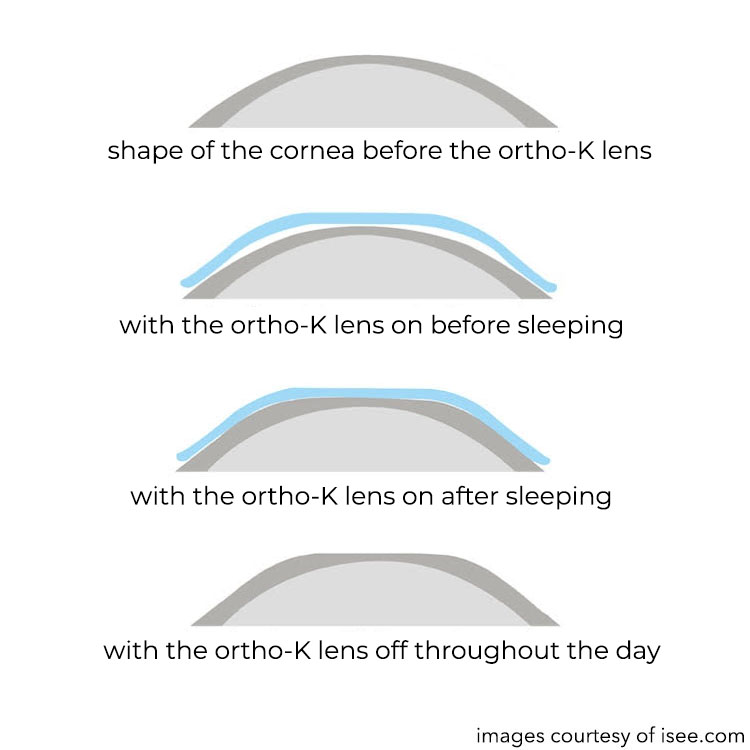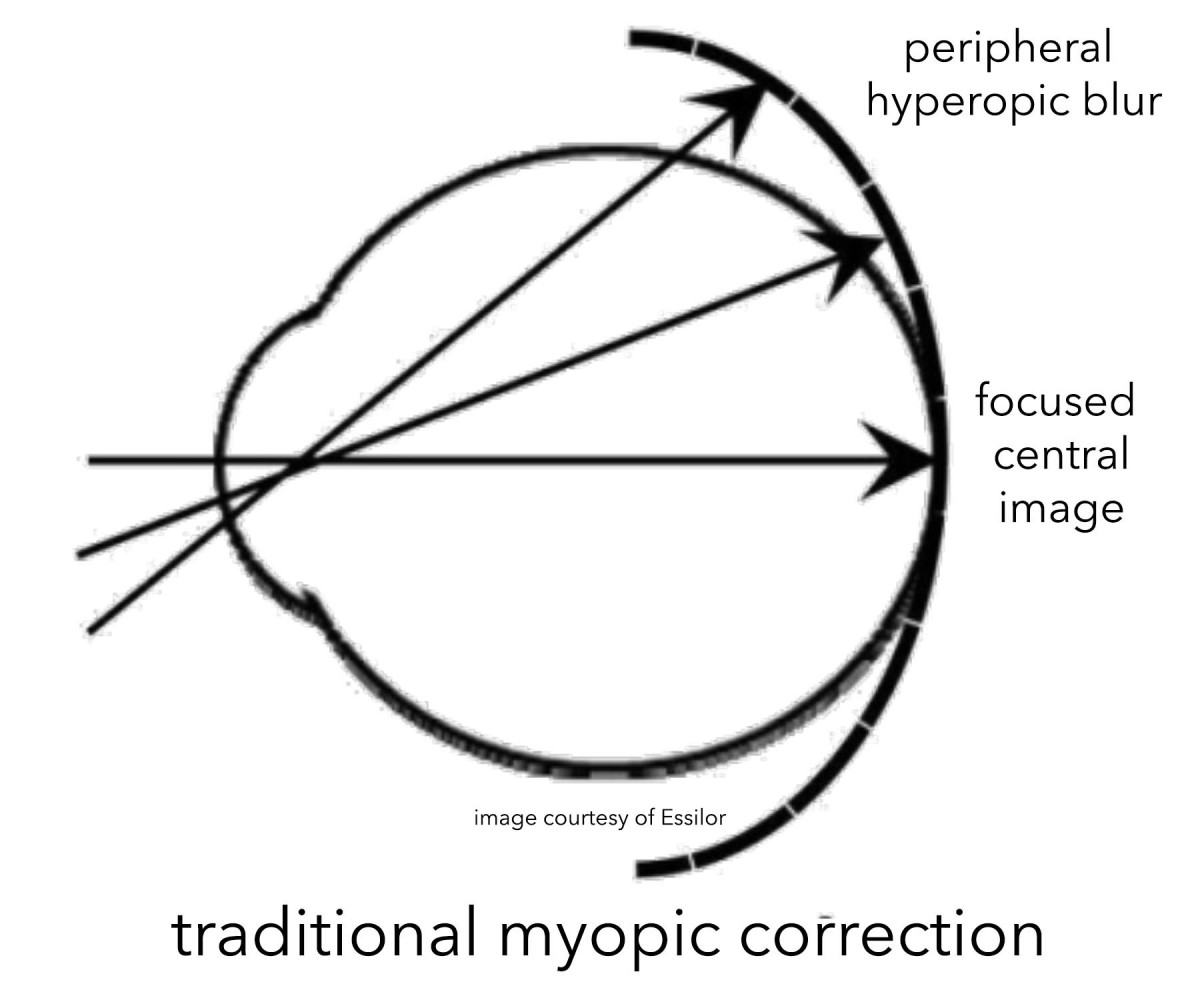What is orthokeratology?
Orthokeratology, or ortho-K, is a non-surgical procedure using specially designed retainer lenses to gently and safely reshape the curvature of the front of the eye to improve vision. These retainer lenses are worn overnight, temporarily molding the cornea to create less dependence on glasses or contact lenses throughout the day. The vision correction can be maintained as long as your keep wearing the lenses and continue care with your optometrist to make any changes to the lens design that may be necessary over time. By the same token, the effects are reversible; if you stop wearing the lenses, your corneas go back to their pre-treatment shape and your vision becomes blurry again.
How does it work?
Short answer: The cornea is the clear, dome-shaped structure in the front of your eye. It focuses light onto the tissue in the back of the eye (the retina). The corneal tissue is flexible, so we can alter its shape, thereby altering how light focuses on the retina. In nearsighted, or myopic, individuals, light focuses in front of the retina, so vision at a distance is blurry. Through the use of ortho-K retainer lenses, we can reshape the cornea to have light focus on the retina, providing a clear image.

Long answer: The ortho-K retainer lenses are specially designed to fit flatter in the center. This makes the tear film underneath the center of the lens thin, while the tear film is thicker in the midperiphery. This creates a negative-pressure gradient, which causes the cells in the outer layer of the cornea (the epithelium) at the center of the cornea to dehydrate and become thin, while the cells in the midperiphery of the cornea take up fluid and become thicker. This redistribution that occurs in the cells of the corneal epithelium essentially makes the center of the cornea flatter and the midperiphery steeper.
Is orthokeratology safe?
The FDA has approved specific ortho-K lens materials with no age limitations. These lenses are made of a highly gas-permeable material, allowing your eyes to “breathe” overnight.
As with any contact lens wear, there is risk of infections and complications, particularly because these lenses are worn overnight. Microbial keratitis is the most serious possible complication of ortho-K, though the risk with ortho-K was found to be similar to other overnight modalities (1). This risk is greatly reduced by following the proper cleaning regimen and maintaining the follow-up visits with your optometrist.
Can orthokeratology slow nearsightedness is kids?
Yes, several studies have shown that ortho-K can slow the progression of nearsightedness in children (2,3).
When a myopic person is corrected with traditional single vision glasses or contact lenses, light focuses on the central part of the retina (making vision clear), but focuses behind the retina in the periphery. This is called peripheral hyperopic defocus or blur, and it is thought to be the stimulus that causes the eye to elongate and become more myopic. Because the ortho-K retainer lens steepens the mid-peripheral cornea, it reverses the peripheral hyperopic defocus that normally occurs, allowing light to focus in front of the peripheral retina, thus reducing the elongation of the eye. Many studies have found this to be an effective form of myopia control (4).

Orthokeratology retainer lenses are FDA-approved to correct myopic refractive error, but not specifically to control myopia; thus, they are used “off-label” for this purpose.
For more info, please read my post on myopia control options.
WHAT CAN I EXPECT?
In order to create an ortho-K retainer lens, your optometrist will get a map of the front part of the eye using a corneal topographer. This device uses light reflected off the eye to map the curvature of the cornea; it does not touch your eye. Your doctor then takes this information along with your prescription and other measurements to design a custom retainer lens for molding your cornea. These lenses are not one-size-fits-all. Much like orthodontics, they are designed specifically for you.
Once the lens has been designed, your optometrist will assess the fit of the lens on your eye, train you how to insert and remove them, as well as how to properly clean and care for the lenses. Once the training is successfully completed, you will then go home and sleep in your new lenses!
Your optometrist will likely follow-up with you the next morning, and generally after 1 week, 1 month, 3-6 months, and every 6 months going forward. This allows your doctor to monitor for changes in vision or changes in corneal curvature that may need to be corrected by altering the retainer lens design. It also allows him/her to check for any complications that may arise.
Most patients reach full correction within two weeks. You may experience slight regression/blurry vision toward the end of the day, but this should improve over time. You may also need multiple temporary retainer lenses until the desired amount of correction is achieved.
“Long-term success of ortho-K treatment requires a combination of proper lens fitting, rigorous compliance to lens care regimen, good adherence to routine follow-ups, and timely treatment of complications.“- Drs Liu and Xie
Am I a good candidate for ortho-K?
- Are you mildly or moderately nearsighted with no/low amounts of astigmatism?
- Are you inconvenienced by glasses and/or contacts?
- Do you have an active lifestyle that would benefit from the convenience of good vision without glasses or contacts?
- Are you interested in LASIK but hesitant about eye surgery?
- Do you have allergies and/or dry eye, making contact lens wear uncomfortable?
- Are you highly nearsighted and concerned about your child’s nearsightedness?
- Is your child’s nearsightedness progressing each year?
If your answer to any or all of the above questions is YES, consider speaking with your optometrist to learn more and determine if ortho-K is right for you.
| CLIFFSNOTES: Orthokeratology uses overnight, custom-fit, gas-permeable retainer lenses to safely reshape the cornea, temporarily and reversibly correcting vision. Ortho-K has also been identified in many studies as an effective and safe method for slowing the progression of nearsightedness in children. Ask your optometrist for more information! |
